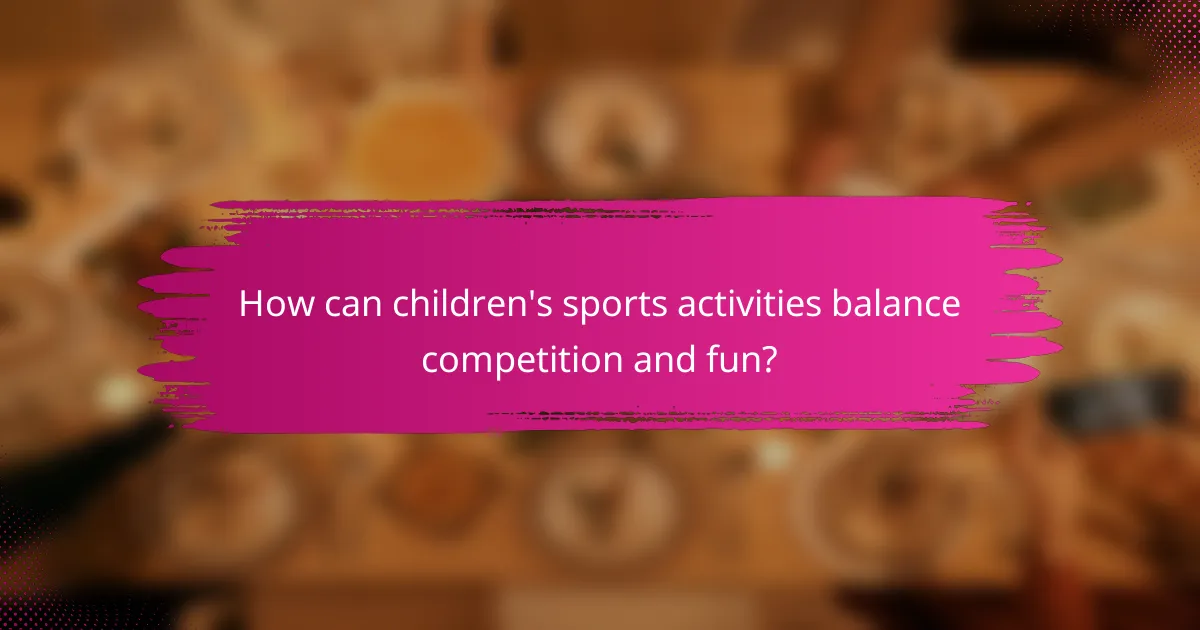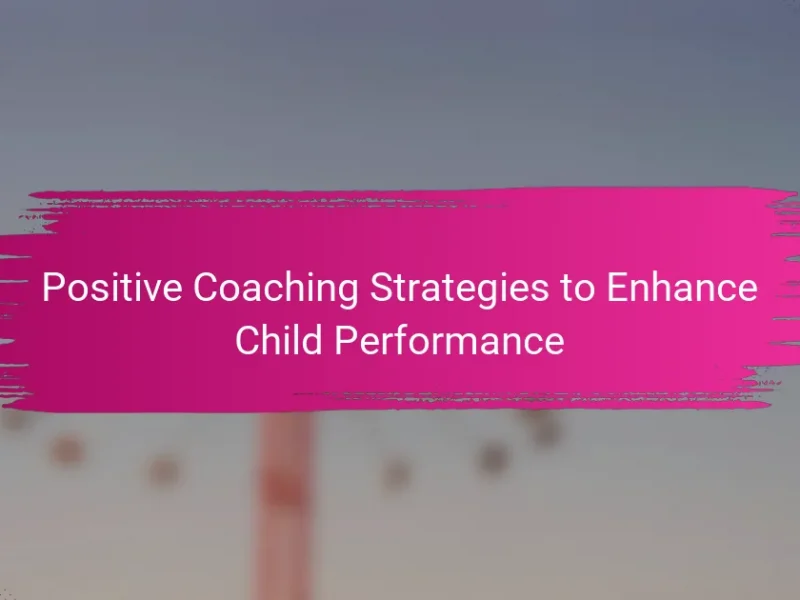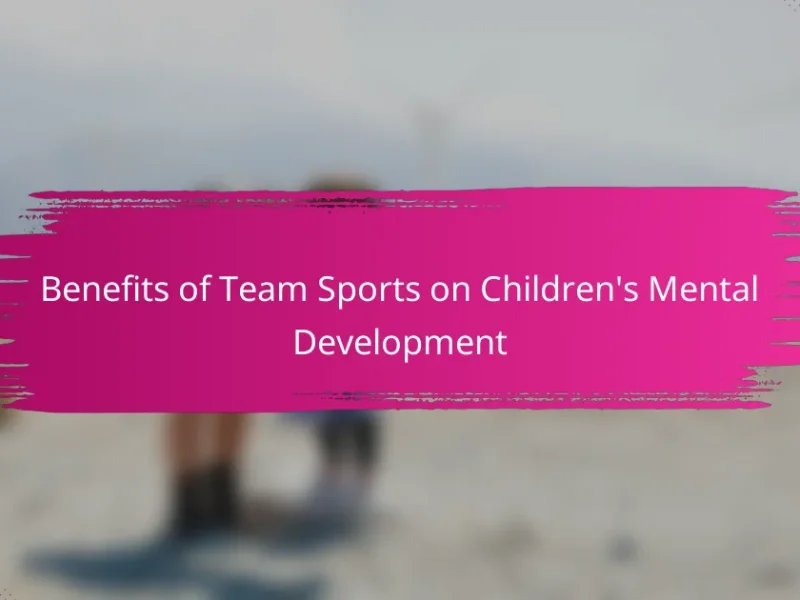Balancing competition and fun in children’s sports activities is crucial for their overall development. This article explores fostering teamwork and enjoyment, integrating varied activities for fitness, setting realistic goals, and incorporating children’s feedback. It highlights the impact of local culture on sports values and emphasizes the importance of an inclusive environment that prioritizes participation over winning.

How can children’s sports activities balance competition and fun?
Balancing competition and fun in children’s sports activities is essential for their development. Focus on fostering teamwork and enjoyment alongside skill improvement. Encourage participation over winning to create a positive environment.
Integrate varied activities that promote physical fitness while allowing children to explore their interests. Highlight the importance of setting realistic goals to maintain motivation without excessive pressure.
Incorporate feedback from children to understand their preferences, ensuring they feel valued and engaged. This approach nurtures a love for sports, balancing competition and fun effectively.
What are the core principles of balancing competition and fun?
Balancing competition and fun in children’s sports activities requires fostering a positive environment. Prioritising enjoyment enhances participation, while healthy competition encourages skill development. Encouraging teamwork and communication promotes social skills, making activities more enjoyable. Setting realistic expectations helps children appreciate their efforts, blending competition with fun effectively.
Why is the balance between competition and fun important for children’s development?
Balancing competition and fun in children’s sports is crucial for healthy development. It fosters teamwork and social skills while promoting physical fitness. Competition can motivate children, but excessive pressure may lead to anxiety and burnout. Fun encourages participation and enjoyment, helping children develop a lifelong love for physical activity. Striking the right balance nurtures resilience and self-esteem, ensuring that children learn valuable life skills through play.
What psychological benefits arise from a fun-focused approach?
A fun-focused approach in children’s sports activities fosters psychological benefits such as enhanced motivation, increased self-esteem, and improved social skills. This approach encourages children to enjoy participation rather than fixate on competition. As a result, children experience reduced anxiety and a greater willingness to engage in physical activities. Fun also promotes creativity and problem-solving skills, essential for overall development. Encouraging a balance between competition and enjoyment creates a positive environment that nurtures emotional well-being and resilience.
How does competition influence children’s social skills?
Competition can enhance children’s social skills by fostering teamwork and communication. While it encourages children to strive for success, it can also lead to anxiety if not balanced with fun. Engaging in competitive sports teaches children to handle both victory and defeat, promoting resilience. Additionally, children learn to cooperate with peers, enhancing their ability to form friendships and navigate social dynamics.

What universal attributes characterize children’s sports activities?
Children’s sports activities universally balance competition and fun. Key attributes include teamwork, skill development, physical fitness, and emotional growth. These activities foster social interactions and build resilience, encouraging children to enjoy the process while learning to compete. Unique aspects may include age-appropriate formats and varied game rules, ensuring inclusivity and engagement for all participants.
What types of sports are commonly involved?
Common sports for children include football, basketball, baseball, swimming, gymnastics, and tennis. These activities balance competition and fun, promoting teamwork and physical fitness. Football fosters collaboration and endurance, while basketball enhances coordination and agility. Baseball develops patience and strategic thinking, swimming builds strength and stamina, gymnastics improves flexibility and balance, and tennis encourages hand-eye coordination. Each sport offers unique benefits, contributing to children’s overall development.
How do age and skill levels impact participation?
Age and skill levels significantly impact participation in children’s sports activities by influencing motivation and competition dynamics. Younger children often prioritise fun and social interaction, while older participants may seek skill development and competitive success.
As children grow, their skill levels typically improve, leading to increased competition. This shift can affect group dynamics, with more skilled players often taking leadership roles. Conversely, varying skill levels within teams can foster teamwork and inclusivity, allowing less experienced players to learn from their peers.
Balancing competition and fun is essential. Programs that adapt to different age groups and skill levels can enhance overall participation. For example, age-appropriate activities encourage engagement, while skill-diverse teams promote a supportive environment.

What unique strategies can enhance enjoyment in sports?
To enhance enjoyment in children’s sports, focus on balancing competition with fun. Encourage teamwork and creativity to foster a positive environment. Incorporate varied activities that cater to different skill levels, ensuring every child feels included and valued. Regularly emphasise personal growth over winning, which can lead to increased motivation and enjoyment.
How can coaches foster a positive environment?
Coaches can foster a positive environment by emphasising enjoyment alongside competition in children’s sports. Encouraging teamwork and celebrating individual progress helps maintain motivation. Coaches should create inclusive practices that cater to varying skill levels, ensuring every child feels valued. Regular feedback and open communication further enhance a supportive atmosphere, allowing children to thrive both socially and athletically.
What role do parental attitudes play in shaping experiences?
Parental attitudes significantly influence children’s experiences in sports by shaping their motivation and enjoyment. Supportive parents foster a positive environment that emphasises fun over competition. Research shows that children with encouraging parents are more likely to develop a lifelong love for sports. Conversely, overly competitive attitudes can lead to stress and disengagement. Balancing these perspectives is crucial for nurturing healthy sports experiences.

What rare attributes contribute to successful programs?
Successful programs in children’s sports activities often include rare attributes like inclusive coaching styles, community engagement, and innovative game formats. These traits foster a balance between competition and fun, enhancing participation and enjoyment. Engaging parents and local organisations can create a supportive environment, leading to higher retention rates. Unique game formats, such as modified rules or mixed-age teams, promote teamwork and reduce pressure, ensuring children focus on enjoyment rather than just winning.
How can innovative formats change traditional sports dynamics?
Innovative formats can enhance children’s sports by fostering engagement and inclusivity. These formats, such as small-sided games or skill challenges, prioritise fun while maintaining competitive spirit. For instance, shorter game durations can keep children’s attention and energy levels high, promoting participation. Additionally, introducing varied activities can cater to different skill levels, ensuring all children feel valued. This balance between competition and enjoyment ultimately encourages lifelong interest in sports.
What are examples of successful initiatives promoting fun over competition?
Successful initiatives promoting fun over competition in children’s sports include community-based programs, inclusive games, and skill-building workshops. These initiatives prioritise enjoyment and personal growth rather than winning. For example, “Playworks” focuses on creating a fun environment in schools, encouraging teamwork and creativity. Another initiative, “The Positive Coaching Alliance,” emphasises the importance of fun and learning in youth sports, helping coaches foster a supportive atmosphere. Additionally, local leagues often organise “fun days” where competitive elements are minimised, allowing children to enjoy various activities without pressure.

How can local cultures influence children’s sports activities?
Local cultures significantly shape children’s sports activities by influencing their values, attitudes, and participation levels. Cultural norms dictate whether competition or enjoyment is prioritised. For example, in some cultures, winning is highly emphasised, which can lead to intense competition. In contrast, other cultures may focus on teamwork and enjoyment, promoting a more relaxed approach. This cultural backdrop affects children’s motivation and engagement in sports. Additionally, community support and resources available for sports can vary widely, impacting the overall experience and development of young athletes. Ultimately, understanding these cultural influences is essential for fostering a balanced environment in children’s sports activities.
What are the common cultural perceptions of competition in sports?
Cultural perceptions of competition in children’s sports often emphasise winning over participation. Many view success as a primary goal, which can overshadow the enjoyment of play. This focus can lead to increased pressure on young athletes, impacting their overall experience. Balancing competition and fun is essential for fostering a positive sporting environment that encourages lifelong participation.
How do different regions approach children’s sports programming?
Different regions balance competition and fun in children’s sports programming through unique cultural approaches. In North America, there’s a strong emphasis on competitive leagues, fostering a win-at-all-costs mentality. Conversely, many European countries prioritise inclusivity and enjoyment, often implementing programs that focus on skill development rather than competition. In Asia, children’s sports often integrate traditional games, promoting teamwork and cultural heritage alongside physical activity.
Regional policies also influence programming. For instance, Australia promotes “Sport for All” initiatives, ensuring accessibility and fun while encouraging physical fitness. In contrast, some regions in South America emphasise community engagement, with local clubs providing a nurturing environment for children to enjoy sports without the pressure of competition.
Overall, the balance between competition and fun in children’s sports programming varies widely, reflecting local values and educational philosophies. This diversity enriches children’s experiences, allowing them to engage with sports in ways that resonate with their communities.

What best practices can be applied to balance competition and fun?
To balance competition and fun in children’s sports activities, emphasise teamwork and skill development. Encourage participation over winning, fostering a supportive environment. Incorporate games that focus on enjoyment while subtly teaching competitive elements. Regularly assess children’s experiences to ensure they find joy in play, maintaining motivation and enthusiasm.
What common mistakes should be avoided in children’s sports activities?
To balance competition and fun in children’s sports activities, avoid common mistakes that can hinder their experience. Emphasising winning over enjoyment can lead to burnout, while ignoring individual skill levels may discourage participation. Pressure from parents or coaches can create anxiety, detracting from the enjoyment of the game. Additionally, neglecting to teach sportsmanship can foster negative behaviour among young athletes. Lastly, failing to provide adequate breaks can lead to physical exhaustion, impacting overall health and enthusiasm for sports.
How can feedback from children shape future sports programs?
Feedback from children can significantly enhance future sports programs by aligning activities with their preferences. Engaging children in discussions about their experiences fosters a sense of ownership and enjoyment. This can lead to a balanced approach that prioritises fun alongside competition.
Children often express a desire for more inclusive and varied activities. Programs that adapt based on this feedback can cater to diverse interests, ensuring all participants remain engaged. For example, incorporating games that emphasise teamwork over competition can enhance overall satisfaction.
Additionally, regular feedback sessions can help identify specific elements that children enjoy or dislike. Understanding these aspects allows program organisers to refine their offerings, making them more appealing and effective. This iterative process can lead to a unique sports culture that prioritises enjoyment and personal growth.
Ultimately, valuing children’s feedback creates a positive environment where they feel heard and motivated to participate. This approach not only enhances their experience but also promotes lifelong engagement in sports.


